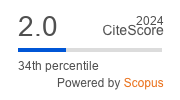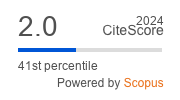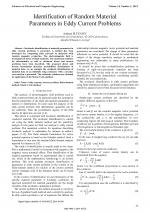| 1/2014 - 4 |
Identification of Random Material Parameters in Eddy Current ProblemsSLUZALEC, A. |
| Extra paper information in |
| Click to see author's profile in |
| Download PDF |
Author keywords
eddy current, inverse problem, finite element method, Monte Carlo method
References keywords
stochastic(7), sluzalec(6), rigid(4), random(4), problems(4), optimization(4), inverse(4), heat(4), forming(4), design(4)
Blue keywords are present in both the references section and the paper title.
About this article
Date of Publication: 2014-02-28
Volume 14, Issue 1, Year 2014, On page(s): 25 - 28
ISSN: 1582-7445, e-ISSN: 1844-7600
Digital Object Identifier: 10.4316/AECE.2014.01004
Web of Science Accession Number: 000332062300004
SCOPUS ID: 84894627983
Abstract
Stochastic identification of material parameters in eddy current problems is presented. A method has been developed for computing eddy currents in materials with random magnetic properties. The electromagnetic field is formulated in terms of finite elements. The numerical solutions for deterministic as well as stochastic direct and inverse problems have been described. The proposed direct and inverse formulation describes probabilistic distributions of material data. As an example the stochastic identification of material data in an infinitely long conductor with a circular cross-section is presented. The stochastic solutions are obtained by application of the Monte Carlo method. |
| References | | | Cited By «-- Click to see who has cited this paper |
| [1] S. Ang, W. H. Tang, "Probability Concepts in Engineering, Planning and Design," Vol. I, Basic Principles. New York: Wiley; 1975.
[2] H. Kesten, "Random difference equations and renewal theory for products of random matrices," Acta Mathematica, 131, pp. 207-248, 1973. [CrossRef] [SCOPUS Times Cited 668] [3] H. J. Larson," Probabilistic Models in Engineering Science," Vols. 1 and 2, New York: Wiley; 1979. [4] E. Vanmarcke, "Random Fields, Analysis and Synthesis," (2nd edn.). Cambridge, Massachusetts: MIT Press, 1984. [5] M. Fisz., "Probability theory and mathematical statistics," Warsaw: PWN. 1967. [6] H. T. Banks, K. Kunisch, "Estimation Techniques for Distributed Parameter Systems," Boston: Birkhauser; 1989. [CrossRef] [7] M. Grzywinski, A. Sluzalec, "Stochastic equations of rigid-thermo-viscoplasticity in metal forming process," Int. J. Eng. Sci. 40, pp. 367-383, 2002. [CrossRef] [Web of Science Times Cited 14] [SCOPUS Times Cited 15] [8] A. Sluzalec, "Simulation of stochastic metal forming process for rigid-viscoplastic material," Int. J. Mech. Sci. 42, pp. 1935-1946, 2000. [CrossRef] [Web of Science Times Cited 14] [SCOPUS Times Cited 18] [9] A. Sluzalec, "Stochastic shape sensitivity in powder metallurgy processing," Applied Mathematical Modelling, 36 (8), pp. 3743-3752, 2012. [CrossRef] [Web of Science Times Cited 7] [SCOPUS Times Cited 7] [10] A. Sluzalec, "Stochastic finite elements in optimization of powder metallurgy materials," Mechanics Based Design of Structures and Machines, 40 (1), pp. 33-41, 2012. [CrossRef] [Web of Science Times Cited 7] [SCOPUS Times Cited 9] [11] A. Sluzalec, "Stochastic sensitivity in metal forming of rigid-poroplastic materials," Structural and Multidisciplinary Optimization, 45 (1), pp. 139-145, 2012. [CrossRef] [Web of Science Times Cited 6] [SCOPUS Times Cited 7] [12] A. Sluzalec, "Temperature field in random conditions," Int. J. Heat Mass Transfer, 34 (1), pp. 55-58, 1991. [CrossRef] [Web of Science Times Cited 13] [SCOPUS Times Cited 15] [13] O. C. Zienkiewicz, The Finite Element Method. New York: McGraw-Hill; 1977. [14] J. E. B. Cardoso, J. S. Arora, "Variational method for design sensitivity analysis in nonlinear structural mechanics," AIAA J., 26, pp. 595-603, 1988. [CrossRef] [Web of Science Times Cited 89] [SCOPUS Times Cited 102] [15] E. J. Haug, J. S. Arora, Applied optimal design. New York: Wiley, 1979. [16] F. Ma, "Approximate analysis of a class of linear stochastic systems with colored noise," Int. J. Eng. Sci., 24, pp. 19-34, 1986. [CrossRef] [Web of Science Times Cited 14] [SCOPUS Times Cited 18] [17] K. Mosegaard, A. Tarantola, "Monte Carlo sampling of solutions to inverse problems," Journal of Geophysical Research, 100, pp. 431-447, 1995. [CrossRef] [Web of Science Times Cited 978] [SCOPUS Times Cited 1111] [18] J. Wang., N. Zabaras, "A Bayesian inference approach to the inverse heat conduction problem," Int. J. Heat Mass Transfer, 47, pp. 3927-3941, 2004. [CrossRef] [Web of Science Times Cited 208] [SCOPUS Times Cited 238] [19] M. Ebrahimi., "Monte Carlo Optimization to solve a Two- dimensional inverse heat conduction problem," Australian Journal of Basic and Applied Sciences, 5 (11), pp. 2097-2105, 2011. [20] V. C. Mariani., L. S. Coelho, "Global optimization of thermal conductivity using stochastic algorithms," Inverse Problems in Science and Engineering, 17 (4), pp. 511-535, 2009. [CrossRef] [Web of Science Times Cited 10] [SCOPUS Times Cited 10] [21] I. Pokorska, Re-identification problems in forming of rigid-visco-poroplastic materials, International Journal for Numerical Methods in Engineering, 73, 8, 1077-1093, 2008. [CrossRef] [Web of Science Times Cited 8] [SCOPUS Times Cited 8] [22] W. M. Rucker, K. R. Richter, "Calculation of two-dimensional eddy current problems with the boundary element method," IEEE Trans.Mag., 6, pp. 2429-2431, 1983. [CrossRef] [Web of Science Times Cited 24] [SCOPUS Times Cited 29] Web of Science® Citations for all references: 1,392 TCR SCOPUS® Citations for all references: 2,255 TCR Web of Science® Average Citations per reference: 61 ACR SCOPUS® Average Citations per reference: 98 ACR TCR = Total Citations for References / ACR = Average Citations per Reference We introduced in 2010 - for the first time in scientific publishing, the term "References Weight", as a quantitative indication of the quality ... Read more Citations for references updated on 2025-06-05 01:04 in 101 seconds. Note1: Web of Science® is a registered trademark of Clarivate Analytics. Note2: SCOPUS® is a registered trademark of Elsevier B.V. Disclaimer: All queries to the respective databases were made by using the DOI record of every reference (where available). Due to technical problems beyond our control, the information is not always accurate. Please use the CrossRef link to visit the respective publisher site. |
Faculty of Electrical Engineering and Computer Science
Stefan cel Mare University of Suceava, Romania
All rights reserved: Advances in Electrical and Computer Engineering is a registered trademark of the Stefan cel Mare University of Suceava. No part of this publication may be reproduced, stored in a retrieval system, photocopied, recorded or archived, without the written permission from the Editor. When authors submit their papers for publication, they agree that the copyright for their article be transferred to the Faculty of Electrical Engineering and Computer Science, Stefan cel Mare University of Suceava, Romania, if and only if the articles are accepted for publication. The copyright covers the exclusive rights to reproduce and distribute the article, including reprints and translations.
Permission for other use: The copyright owner's consent does not extend to copying for general distribution, for promotion, for creating new works, or for resale. Specific written permission must be obtained from the Editor for such copying. Direct linking to files hosted on this website is strictly prohibited.
Disclaimer: Whilst every effort is made by the publishers and editorial board to see that no inaccurate or misleading data, opinions or statements appear in this journal, they wish to make it clear that all information and opinions formulated in the articles, as well as linguistic accuracy, are the sole responsibility of the author.



